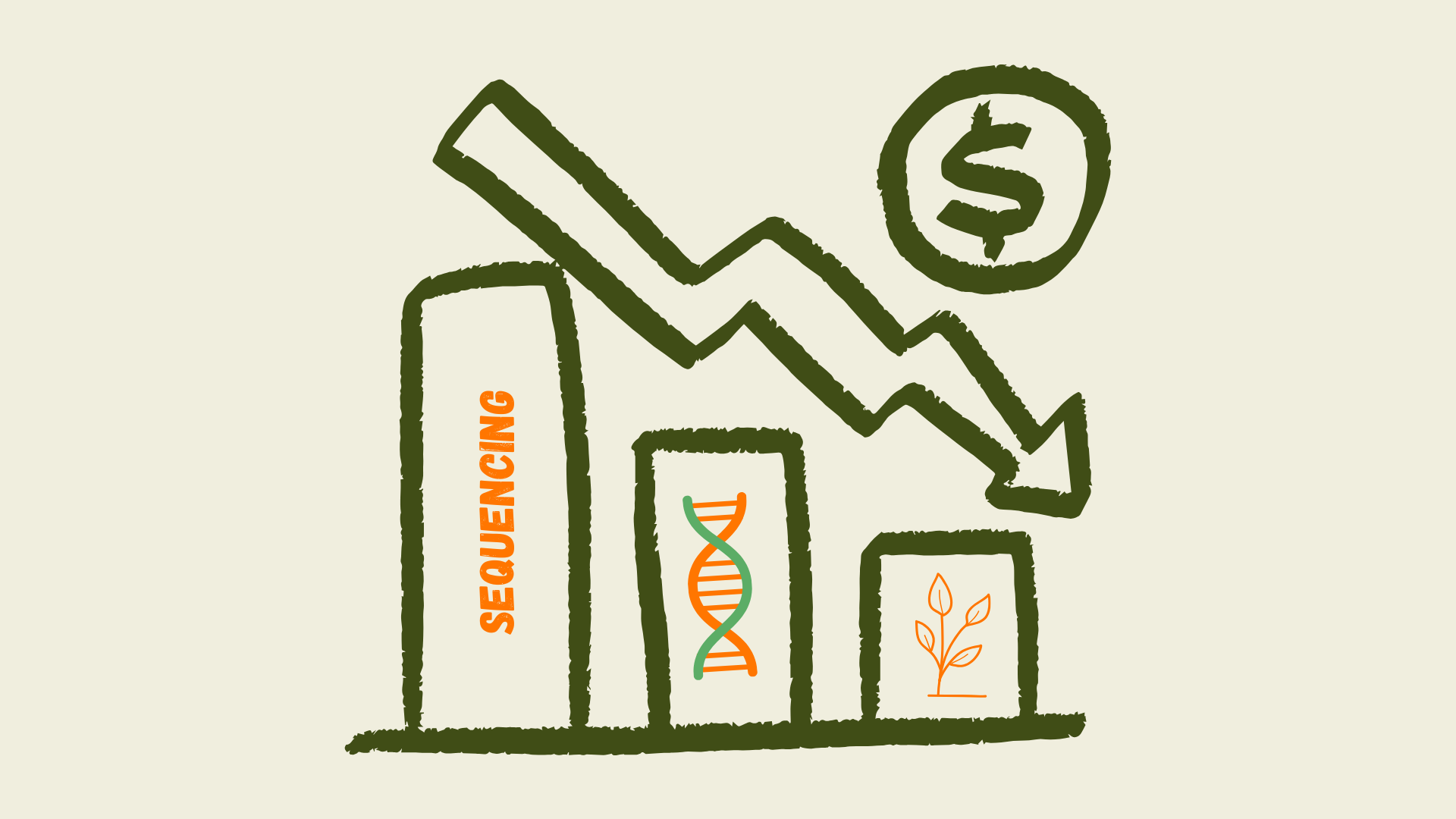TOPICS
- Smart and Affordable Genotyping Strategies (infographics)
- SNP Markers in Modern Breeding: Advantages and Cost-Effective Genotyping Methods
- Case Study: How to Implement a Low-Cost Marker-Assisted Selection (MAS) Pipeline in Your Breeding Program (infographics)
Molecular breeding has revolutionized crop improvement, enabling breeders to make faster and more precise selection decisions. However, many small and medium-sized breeding programs hesitate to adopt molecular tools due to perceived high costs. The good news? Affordable genotyping strategies exist, allowing breeders to harness molecular breeding without breaking the bank.
With the right strategy, even small breeding programs can take advantage of genotyping without excessive costs. Let’s look at how.
Smart and Affordable Genotyping Strategies
1️⃣ Start Small: Use Low-Density Marker Panels
For breeders looking to integrate molecular markers on a limited budget, panels of low-density SNP (Single Nucleotide Polymorphism) and KASP technology (Kompetitive Allele-Specific PCR) markers offer affordable solutions. SNPs are the markers of choice for breeders due to their ability to target specific genetic variations, making them ideal for marker-assisted selection (MAS) to screen for key traits like disease resistance and for parent verification in hybrid breeding programs.
KASP markers, on the other hand, are the most suitable technology for detecting these SNPs in a cost-effective and flexible way, enabling breeders to run a small number of markers for varying number of plants.
2️⃣ Outsource Genotyping Instead of Setting Up a Lab
Setting up an in-house genotyping lab requires specialized equipment, reagents, and trained personnel, which can be expensive. Instead, breeders can outsource genotyping to specialized service providers that offer cost-effective bulk pricing.
Popular options include Genotyping-by-Sequencing (GBS), a low-cost method to generate genome-wide marker data for breeding populations, and shared genotyping platforms, where multiple breeders pool samples to reduce per-sample costs. These alternatives provide breeders with access to advanced genotyping technologies without the high investment of setting up their own lab.
3️⃣Targeted Genotyping: Only Screen What You Need
Rather than genotyping entire populations, small breeding programs can reduce costs by focusing only on key individuals.
To prioritize genotyping, breeders can screen only elite breeding lines instead of all progeny.They can use bulk segregant analysis (BSA) by pooling DNA from plants with extreme phenotypes to identify markers faster. They can also select markers specifically for traits of interest, such as disease resistance or drought tolerance, instead of performing whole-genome scans.
Additionally, breeders should maintain historical genotyping data for their germplasm to avoid repeating genotyping for markers in which the pedigree does not segregate, thus preventing unnecessary costs. A well-revised and curated database of genotyping data is essential to optimize resources and improve efficiency.
4️⃣Use Publicly Available Marker Data and Open-Source Tools
To find free marker data, breeders can access public databases like Gramene, SoyBase, or Sol Genomics, which provide trait-linked markers. They can refer to published research articles that often report validated markers for key breeding traits. They can also participate in breeding networks and research collaborations that share useful marker information.
By utilizing these resources, breeders can save time and costs while benefiting from the latest scientific advancements in marker development.
5️⃣Partner with Research Institutions and Molecular Breeding Initiatives
Collaborating with universities, government breeding programs, or international research organizations can provide low-cost or subsidized access to genotyping.
Breeders can join breeding consortia, such as CIMMYT, IRRI, or national seed programs, to access molecular marker technologies. They can apply for grant-funded projects that support small breeding programs in adopting molecular tools. They can also partner with service providers like AgroSynapsis 😉, which specialize in cost-effective molecular breeding solutions.
These collaborations help breeders leverage advanced technologies while minimizing costs.
With a modest budget, small breeding programs can integrate molecular breeding.

Check out the infographic below how to get start with smart and affordable genotyping strategies

SNP Markers in Modern Breeding: Advantages and Cost-Effective Genotyping Methods
What Are SNPs and Why Are They Preferred Over Older Markers?
A Single Nucleotide Polymorphism (SNP) is a variation at a single DNA base position in the genome. For example, in one plant, a DNA sequence may read AAGCCTA, while in another variety, the same region may have AAGCTTA. This single base-pair difference is called an SNP.

SNP markers have become the standard in molecular breeding because they offer advantages over older marker types (see table below).
| Marker Type | Disadvantage | Technical Challenge |
| SSR (Simple Sequence Repeats / Microsatellites) | Complex to score | Requires specialized equipment |
| CAPS (Cleaved Amplified Polymorphic Sequences) | Slower and less scalable | Requires enzyme digestion of PCR products |
| AFLP (Amplified Fragment Length Polymorphism) | Less reproducible | Requires large amounts of DNA |
| RAPD (Random Amplified Polymorphic DNA) | Less reproducible | Requires large amounts of DNA |
SNPs are the better choice for molecular breeding because they are more abundant and evenly distributed across the genome, providing precise genetic information. SNP assays can be automated to process thousands of samples at once, reducing the cost per sample.
Unlike SSRs, SNPs produce consistent results across different labs and genotyping platforms. Advances in technology have made SNP genotyping more affordable than SSR genotyping per data point, with platforms like KASP and GBS offering cost-effective solutions for budget-conscious breeders.

Cost-Effective Genotyping for Breeders: KASP, GBS, or Whole-Genome Sequencing?
KASP Genotyping – A Budget-Friendly SNP Assay
KASP (Kompetitive Allele-Specific PCR) is a widely used, cost-effective SNP genotyping method ideal for small breeding programs. It detects SNP differences in DNA samples using fluorescent probes, offering an affordable and flexible solution.
KASP is one of the cheapest SNP genotyping methods available and works with both small and large marker sets (5 to 100 SNPs). It provides high accuracy with clear, reproducible results. This method is best for screening plants for specific traits like disease resistance and drought tolerance, parental verification in hybrid breeding, and marker-assisted selection (MAS) in small breeding programs.
Depending on volume, the cost ranges from approximately $0.10 to $1 per sample per SNP.
Genotyping-by-Sequencing (GBS) – A Low-Cost Whole-Genome Approach
Genotyping-by-Sequencing (GBS) is a cost-effective method for scanning thousands of SNPs across the entire genome. Unlike KASP, which selects a small set of markers, GBS uses DNA sequencing to discover and analyze SNPs genome-wide. It captures genome-wide variation, making it ideal for identifying novel markers. It is also cost-efficient for large populations, offering a cheaper alternative to whole-genome sequencing.
Additionally, GBS requires no prior marker development, making it useful for crops with limited SNP databases. This method is best suited for genomic selection, where superior plants are chosen based on genome-wide marker data, diversity analysis to study genetic relationships among breeding lines, and developing new SNP markers for KASP assays.
Depending on sequencing depth, the cost ranges from approximately $10 to $30 per sample.
📢 Pro Tip: If your breeding program doesn’t need thousands of SNPs, you can use GBS to identify key markers, then switch to KASP for routine selection to save money.
Direct DNA Sequencing – When to Consider It?
Whole-genome sequencing (WGS) provides the most comprehensive genetic information but is not always necessary for small breeding programs.
It is best suited for cases where a breeder wants to discover new genes or mutations, or when no existing marker data is available for a particular crop. It is also ideal when a high level of genetic detail is required for breeding strategies like genomic selection. Depending on coverage, the cost ranges from approximately $500 to $1,500 per genome.
SNP genotyping provides breeders with a range of cost-effective options—KASP for targeted and budget-friendly selection, GBS for genome-wide insights at a moderate cost, and WGS for the most comprehensive genetic analysis. Choosing the right method ensures the best balance between precision and affordability. 💰🔬
Case Study: How to Implement a Low-Cost Marker-Assisted Selection (MAS) Pipeline in Your Breeding Program
To illustrate how a small breeding program can affordably implement molecular tools, let’s consider a hypothetical case study of a vegetable seed company working on Phytophthora resistance in tomatoes.
The challenge faced by a small tomato breeding program is developing varieties resistant to Phytophthora infestans. Traditionally, breeders screen plants in the field, but disease testing is time-consuming, requiring plants to be grown to maturity; expensive, as field trials demand labor, space, and pathogen inoculation; and unreliable, as it is influenced by environmental variability. The goal is to implement a low-cost molecular selection strategy that reduces field screening costs while keeping genotyping expenses minimal, offering a more efficient and cost-effective alternative.
1️⃣Identify a Cost-Effective Marker for Phytophthora Resistance
The breeder searches public databases and published research, finding a well-characterized SNP marker linked to Phytophthora resistance in tomatoes. This cost-saving strategy eliminates the need to develop new markers by using existing SNP markers from public research, and it avoids the expense of whole-genome sequencing by focusing only on a few key markers. The breeder benefits from published data, which identifies candidate SNPs associated with Phytophthora resistance, after validating them in a panel for tomato accesions with contrasting phenotypes for the disease.
The breeder aims to introduce the locus of resistance into his germplasm by crossing one of tomato accessions with the resistanc locus to a susceptible line.
2️⃣Choose an Affordable Genotyping Method
The breeder considers two budget-friendly genotyping options: KASP Assay, which is cost-effective for a small number of markers, and Genotyping-by-Sequencing (GBS), which is useful if more markers are needed in the future. For this case, the breeder chooses KASP, as only one key SNP needs to be screened. The estimated cost for KASP genotyping is approximately $1 per sample.
3️⃣Collect DNA Samples
Instead of using expensive leaf tissue extraction kits, the breeder uses a low-cost DIYDNA extraction protocol. The cheap DNA extraction method involves using an alkaline buffer or a quick CTAB protocol, costing approximately $0.10 per sample, eliminating the need for expensive lab kits.
4️⃣Screen F2 Tomato Seedlings Early
Rather than waiting for mature plants to show disease symptoms, the breeder screens seedlings at the 2-3 leaf stage with the KASP assay. This approach saves money by eliminating non-resistant plants early, reducing the space and resources needed for later testing, and allowing faster breeding cycles by selecting resistant individuals immediately.
5️⃣Validate Results with a Small Field Trial
After genotyping, the breeder selects only the top, for example, 200 resistant plants for a small-scale disease screening trial. This is cost-effective because instead of testing hundreds of plants in a large, costly trial, only 200 are tested, saving field space, labor, and pathogen inoculation costs. The cost-saving strategy involves genotyping first and phenotyping second, which reduces the trial size, and selecting only the best candidates, focusing resources on promising lines.
Results: A Faster and Cheaper Selection Pipeline
Molecular selection reduced breeding time by 1 year and saved several thousands of dolars in field trial costs by eliminating susceptible plants early, and allowed for more precise selection, with selected plants having a 90% survival rate in disease trials.
Molecular breeding isn’t just for large seed companies with big R&D budgets. By choosing affordable genotyping strategies, leveraging public marker resources, and outsourcing wisely, even small breeding programs can integrate molecular tools into their selection pipelines.

Check out the infographic below for a case study how to set up up a cost-effective MAS pipeline

🔹 Ready to Get Started?
At AgroSynapsis, we specialize in cost-effective genotyping solutions tailored for small and medium-sized breeding programs. Whether you need help selecting markers, outsourcing genotyping, or analyzing your data, we’re here to support you.
📩 Contact us today to discuss how we can help you implement molecular breeding on a budget!


